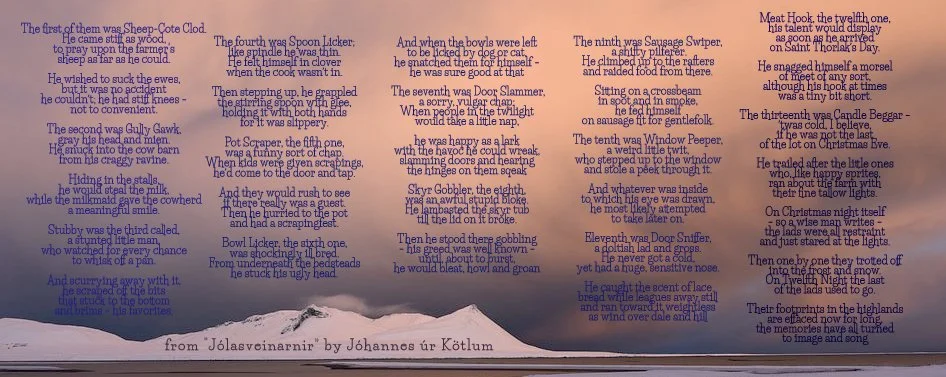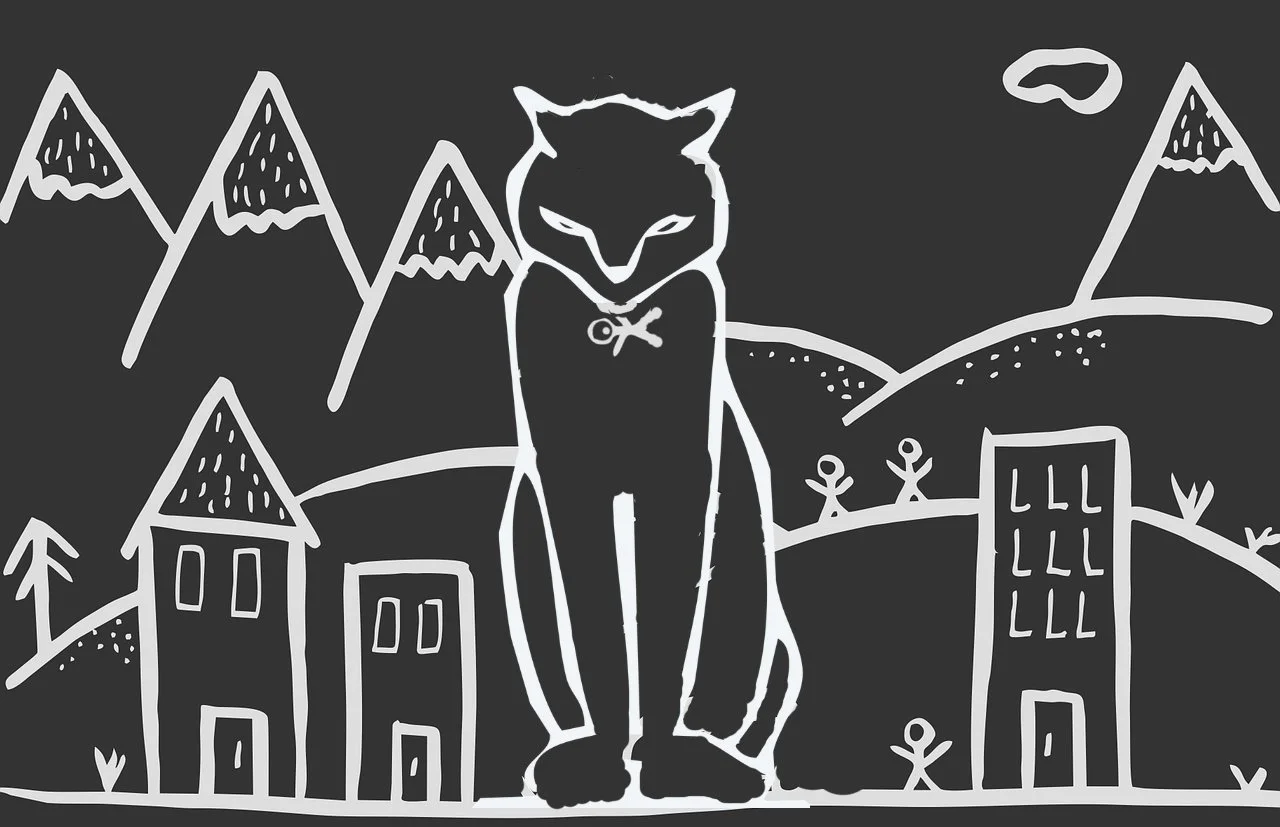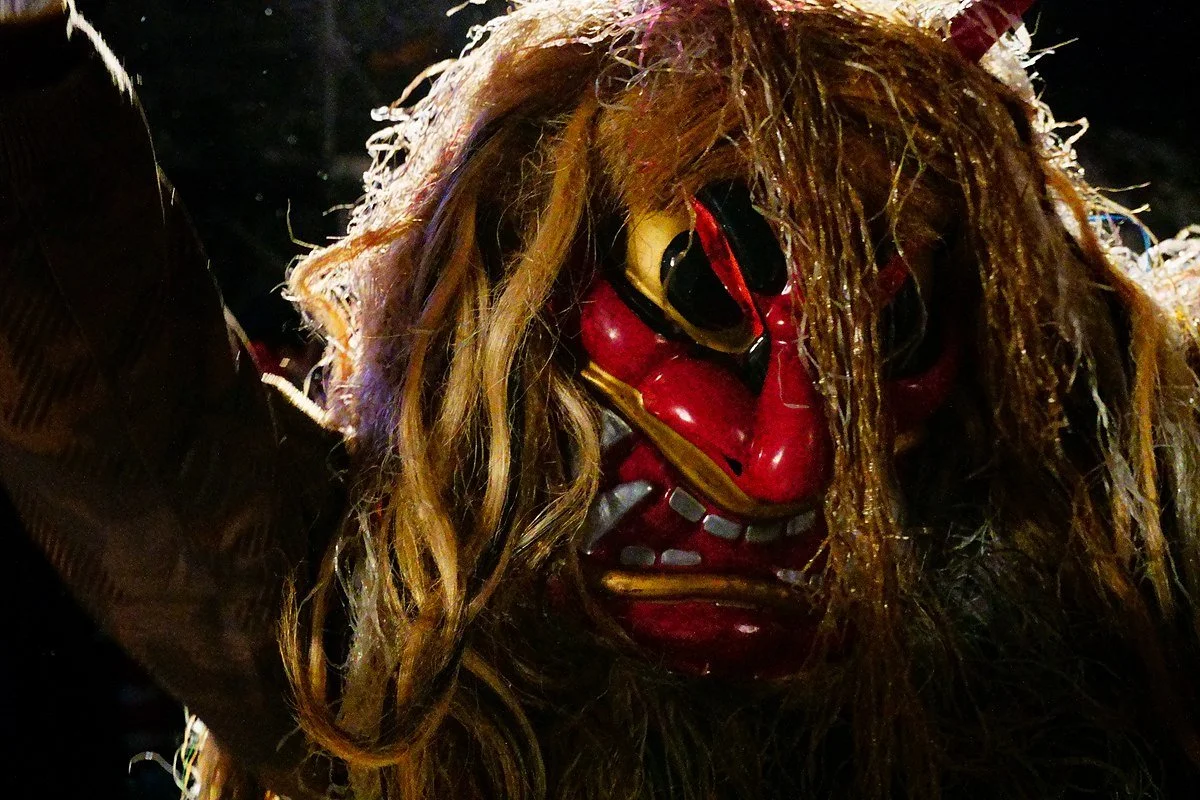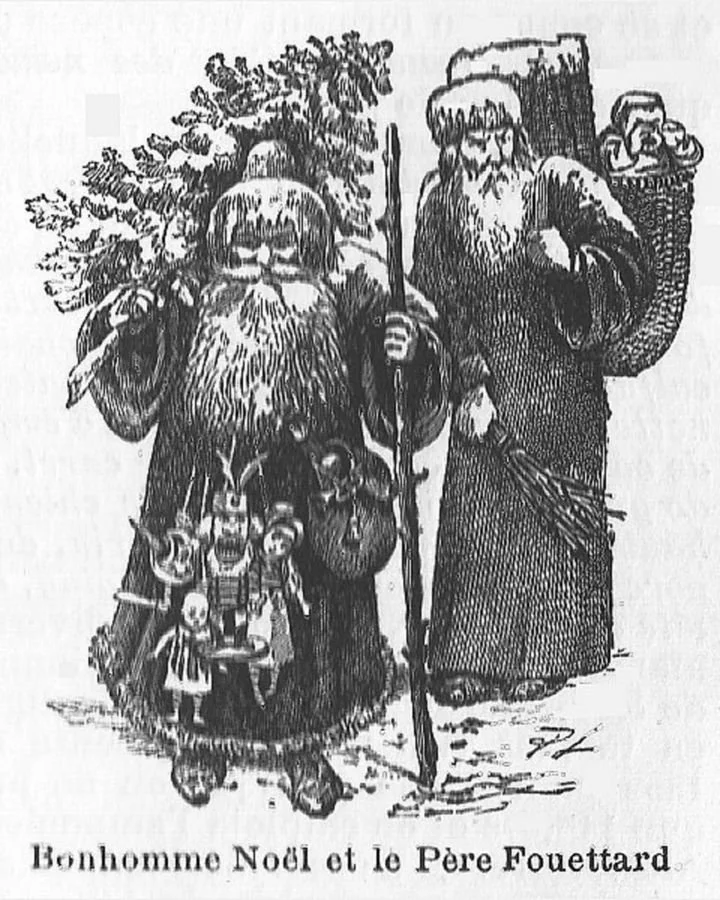Many cultures believe that the veil between the worlds is thin on the longest night.
Beings from other worlds can enter the human realm.
In some places this meant that ancestors would return for a festive meal but sometimes troublesome beings of dark intent are released into the world to worry humanity
Greece- Kallikantzaroi
Kallikantzaroi stay underground sawing the world tree, so that it will collapse, along with Earth
The Kallikantzaroi (singular-Kallikantzaros) are tiny goblin-like creatures who live beneath the surface of the Earth at the roots of the World Tree. All year, these little creatures saw away at the root of the tree to collapse all of creation. At Winter Solstice, their work is nearly done as the vitality of creation is nearly depleted. But at dawn on the 25th of December, there is a breach that allows them to climb into our world and create mischief. This opportunity distracts the beasties, who are not very smart, from their attack on the World Tree.
The Kallikantzaroi are said to be quite ugly. Some sources report them to be like little black skinned humanoids with long tails but others claim they are many shaped, always with some kind of animal characteristic like hooves or the ears of a donkey. These subterranean dwellers are nearly blind when they reach the surface.
They may be found out of doors at night, where they will jump onto the backs of unsuspecting people to ride them mercilessly until the break of dawn. They are also known to break into people's homes to destroy furniture, making a general mess for their own amusement. It is recommended to keep the fire going in the fireplace all night long to prevent them from using this as a way to enter a home.
Since they are not very smart, they can be distracted by placing a colander on one's porch or doorstep. The little fellas cannot count past two for the number three represents the holy trinity so to speak the number will cause their death. Nonetheless, a kallikantaros will obsessively stay at the colander counting the holes by twos until the light of day. Another preventative was to burn old shoes, using the stench to keep the little demons at bay.
There is a more sinister twist to these creatures in Turkey where the karakoncolos can call out in the cold a snowy night, using the voice of a loved one to lure people from the safety and warmth of their homes. Unless the charmed person can be awakened from this spell, they may be lured to freeze to death in the night.
The kallikantzaroi remain on the surface for the 12 days of Christmas which allows the World Tree time to renew itself before they return to begin their erosion once again.
These creatures are in the mythos of southeastern Europe including Bulgaria, Macedonia, Serbia, Turkey, Bosnia and Herzegovina
BTW: Any child born during the twelve days was considered to be in danger of becoming Kallikantzaroi. The antidote was to bind the baby in tresses of garlic or straw, or singe the child's toenails in a fire
Iceland- Jólasveinarnir ( The Yule Lads)
The Yule Lads are the sons of the fearsome ogress, Grýla and her husband, Leppalúði.
Each Christmas season, Grýla's 13 boys descend from the mountains to stir up trouble. The Lads have been around since the 17thC though they have been tamed down as the years have passed. Originally, these ogres were said to eat children so their tales were told to frighten little humans into proper behaviour.
For a long time there was no real agreement on how many Yule Lads there were but in 1932 a poem called "Jólasveinavísur” was written by Jóhannes úr Kötlum to describe and classify these visitors. His poem has become the definitive work so his list of 13 Yule Lads became the standard.
The Lads arrive one by one and depart the same way after their work is done.
Each night of the Yule Lads reign, children in Iceland place their shoes on the windowsill along with a specific treat, depending on the Yule Lad that is expected. Spoon-licker likes a spoon covered in batter, whereas the Candle-Stealer is looking for tallow to eat. If the child has been good, they will awaken to shoes filled with toys or candy. If the child has been bad, they can expect to find a potato.
Kötlum's list introduces the lads thus:
1- Sheep-Cote Clod likes to mingle with the sheep and suckle on the ewes
2- Gully Gawk hides his grey head in ravines until he can sneak into barns to steal foam from the milk buckets
3- Stubby, a very short and stout ogre, steals food from frying pans
4- Spoon-licker, a spindle thin fellow, watches for the cook to leave the kitchen so he can steal a taste from the spoons
5- Pot Scraper steals unwashed pots out of the kitchen so he can scrape them clean at his leisure
6- Bowl Licker grabs up bowls of food left for pets and finishes the food off down to licking the bowl
7- Door Slammer likes to wait until evening when people settle down to nap so he can slam doors
8- Skyr Gobbler is obsessed with getting as much skyr as he can eat. (Skyr is a sort of Icelandic yogurt served cold with milk and sprinkling of sugar on top)
9- Sausage Swiper hangs in the rafters near the fire so he can pilfer sausages as they are being smoked
10- Window Peeper is always on the lookout for something to steal
11-Door Sniffer with his huge nose is searching for Laufabrauð (a flat thin pastry approx 6in/ 15 cm wide- fried in oil)
12- Meat Hook steals any meat left unattended but has a particular taste for smoked lamb
13- Candle Beggar steals precious light giving candles. In ancient times candles were made from tallow so he was likely to eat his ill gotten gains
“Jólasveinarnir” by Jóhannes úr Kötlum
Let me tell the story
of the lads of few charms,
who once upon a time
used to visit our farms.
Thirteen altogether,
these gents in their prime
didn´t want to irk people
all at one time.
They came from the mountains,
as many of you know,
in a long single file
to the farmsteads below.
Creeping up, all stealth,
they unlocked the door.
The kitchen and the pantry
they came looking for.
Grýla was their mother –
she gave them ogre milk –
and the father Leppalúdi;
a loathsome ilk.
They hid where they could, with a cunning look or sneer,
ready with their pranks
when people weren´t near.
They were called the Yuletide lads
– at Yuletide they were due –
and always came one by one,
not ever two by two.
And even when they were seen,
they weren´t loath to roam and play their tricks – disturbing
the peace of the home.
© Hallberg Hallmundsson (English translation/Copyright)
Iceland- Jólaköttur (The Christmas Cat)
The Ogress, Grýla, has an enormous black cat which also creeps down into the world from the mountains during the Yule season. The Jólaköttur stalks the land to eat anyone who has not received new clothes for Christmas/ Yule. (In kinder versions of the myth, the cat eats the food of those who have not received clothing)
Some claim the Yule Cat is an ancient myth but the Yule cat appears in written accounts in the 19th century. It is thought that the legend came about as a means of motivating textile workers. It was tradition for textile workers to be gifted with new clothes as a bonus for completing, before Christmas arrived, the processing of the wool that was gathered in the autumn. Lazy workers who were unable to make the deadline would not receive new clothes therefore would be in danger from the Jólaköttur.
Barvaria- Krampus
Krampus (from the German krampen “claw”) is the companion of kindly, philanthropic St Nicolas. Once St Nick had determined which children were naughty and which were nice, he and Krampus took to the streets to dispense the judgement. St Nicolas rewarded the good with gifts while the naughty were given to the Krampus to punish.
Krampus is a horned, hooved, hairy spectre whose task is to scoop naughty children up in a sack and carry them away. He is is often portrayed carrying a bundle of birch twigs (German- ruten) which he traditionally used to whip the children that had been set for punishment. This sinister visitor sometimes took children to a fiery underworld in a wagon.
In many of the countries where St Nicolas brings gifts on Dec 6, such as Italy and Austria, the night preceding is known as Krampusnacht. Given over to wild revels, parades known as Krampuslauf (Krampus Run) are held, where costumed devils and witches cavort through the streets with torches and an intent to frighten.
Japan- Namahage
The namahage are a type of Oni (demon) of Japanese folklore. Their name refers to the resulting blisters that can happen when one spends long winter hours staying warm around an open flame. In Akita Dialect, these blisters are called Namomi. The term Namomihagi means ‘peeling off the blisters’ meaning to not be lazy. It eventually became shortened to Namahage.
In Oga, on New Year’s Eve, locals don the traditional costumes of knitted straw (kede), straw capes (mino), and their fearsome blue (male oni) or red (female oni) masks to take to the streets carrying massive ax-sized knives, noise making and shouting for lazy children and wives to be punished. The namahage must be appeased by assurances from the man of the house that his wife and children are early rising hard workers. A bribe of mochi (rice flour cake) will not go amiss.
The Legend of the Namahage
Around 200 BCE, the emperor Wu travelled to Oga on a quest for the ingredients that could be combined to mix up an elixir of immortality. He was accompanied by five bats who took the form of demons and toiled industriously on behalf of the emperor. There came a day when the five demons asked for a day off. Upon receiving permission from the emperor, the five descended to the village where they stole crops, animals and a few young girls. The villagers went to the emperor beseeching that he bring the demons to heel.
A wager of sorts was struck between the people of the village and the emperor. The demons were given the space of a single night to create a staircase of a thousand steps from the beach to the Goshado shrine at the summit of the mountain. If the staircase could be completed before the first crow of the rooster, the demons would be rewarded with the tribute of a girl every year. If the demons failed, they would depart and never return to Oga.
The villagers did not believe the demons could possibly achieve this goal so grew increasingly nervous as the demons swiftly shaped the stone staircase with infernal speed. As step 999 was being placed, the people of Oga had their village fool mimic the call of the first rooster crow of the morning.
The demons were poor losers. They were so enraged at their loss that they ripped up an ancient cedar tree as they raged their way off the mountain, left Oga and never returned.
France- Le Père Fouettard
The Bishop of Myra, known to us as St. Nicholas (270-343 AD) was born to Greek parents on the southern coast at Patara. He traveled extensively helping people, especially children, and eventually became the patron saint and protector of children. In some European countries, St Nick delivers gifts to well behaved children on Dec 6.
In France, St Nick has a companion known as Le Père Fouettard (Father Whipper) who is tasked to dispense punishment to children who have not been good. Le Père Fouettard's origin tale is appropriately gruesome. Once he had been a butcher in a village that was experiencing a famine. Desperate to supply food to the hungry, the butcher captured and killed 3 young boys, dismembered them and tossed their flesh into a salting tub.
St Nicolas arrived to order a meal from the butcher, insisting that he would have whatever was in the salting tub. The butcher dropped to his knees in front of the saint and confessed his terrible deed. The saint placed a hand above the salting tub, initiating the miracle of resurrecting the 3 boys. The lid was removed and there were the children, whole again and waking as if from a dream. Nicolas made certain the boys returned to their parents.
The butcher was given the opportunity to atone for his sins by becoming St Nicolas' traveling companion, Le Père Fouettard. Father Whipper's task is to punish naughty children even as the good children are rewarded by St Nick.
Fouettard is portrayed as a dark, dishevelled man carrying a long stick or a whip, carrying a wicker backpack so that he can carry off any who are particularly wicked.
Netherlands- Zwarte Piet
Freddie Langeler, Public domain, via Wikimedia Commons image
Zwarte Piet or Black Pete is generally agreed upon to have been introduced by a schoolteacher from Amsterdam, Jan Schenkman, in an illustrated book, “Sint Nikolaas en zijn Knecht”, in 1850. The story is told that St Nick arrives from Spain by steamship. Alongside he has a traveling companion who manages the bag of gifts. When the sack of toys for the good children is finally empty, Zwarte Piet would then fill the bag with all the children who had been bad and take them back to Spain with him.
Zwarte Piet is generally portrayed by a costume consisting of blackface makeup, curly wigs, enlarged red lips, and gold earrings. In 2011, a campaign was begun by Jerry Afriyie and Quinsy Gario to review the representation of the character of Zwarte Piet as racist. Since then, violent protests have occurred around the seasonal parades of St Nick as the portrayals of Zwarte Piet are considered an embarrassing reminder of the Dutch history of slavery.






